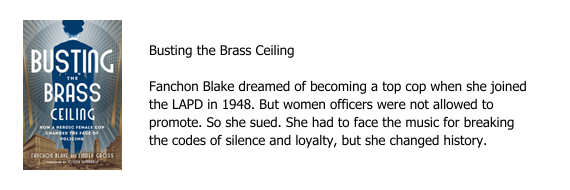Life and work can definitely get in the way of carving out writing time. Having decided to revise and self-publish Busting the Brass Ceiling: How a Heroic Female Cop Changed the Face of Policing, I put my children’s book writing on hold. That’s nothing new. I got the idea for my children’s book series, which I thought would appeal to young readers, 25-plus years ago. I still like the concept, so at least that has held up and passed the test of time. But enough is enough. Having made a concerted effort to get way ahead on a few other fronts, it’s time to put myself to the test and see if I can do this.
I’ve already got four of the books plotted out. I want to outline two more, but before I do any more work on that front, I’ve decided that I should figure out a few children’s book basics, starting with the age group I’m targeting. Just as you need to specify your audience when writing for adults rather than assuming your book is for everyone, you need to figure out just who is going to read the kids’ book you’re writing, how old they are and their expectations when it comes to everything from topic and length to style and complexity.
Here’s how the age categories tend to break down for the young readers set, notwithstanding all those precocious kids who will be reading above their age level nor those who will continue to love picture books into their adulthood:
Board Books & Picture Books – Ages 0-6
These picture-driven books still need strong stories, but they rely on images as well as words to capture the attention of kids up to 6 years old. While picture books like The Runaway Bunny and Dora the Explorer only have about 500 words, the intricacy of the story will determine just where they hit on the age scale, which probably starts with 3-year-olds. Board books like Pat the Bunny or Goodnight Moon, written for babies and toddlers, are even shorter in length, topping out at about 100 words and often having no more than 20 to 30 words.
Easy Readers – Ages 6-7
Geared to kids who aren’t quite ready to handle big chunks of text but want more than picture books have to offer, easy readers, also known as early readers, will feature word counts ranging from 1,000- to 5,000 words (or half that upper end, according to some experts) along with simple sentences, large type, word or phrase repetition, and plenty of illustrations that help clue in its young readers. Early readers bridge the gap between picture books and chapter books and often are part of a series so that kids who become fans can gobble up one after the other. I love the Miss Spider books. Ferdinand the Bull remains an all-time favorite. Mo Willems’ Elephant and Piggie Books makes a lot of best-of lists in this category.
Early Chapter Books (Ages 7-9)
Early chapter books also tend to come in series. They’re a little longer, weighing in at 5,000- to 10,000 words. While they do feature illustrations, they’re more likely to be pen-and-ink drawings rather than full-color pictures since the emphasis now lies with words rather than graphics. Classics and three of my favorites are Charlotte’s Web, Stuart Little and The Secret Garden. The Boxcar Children has had massive staying power. But for fun and science, you can’t beat The Magic School Bus series.
I hope this age and word-count breakdown for young readers helps. I’ll review book categories for older kids next month.




















0 Comments